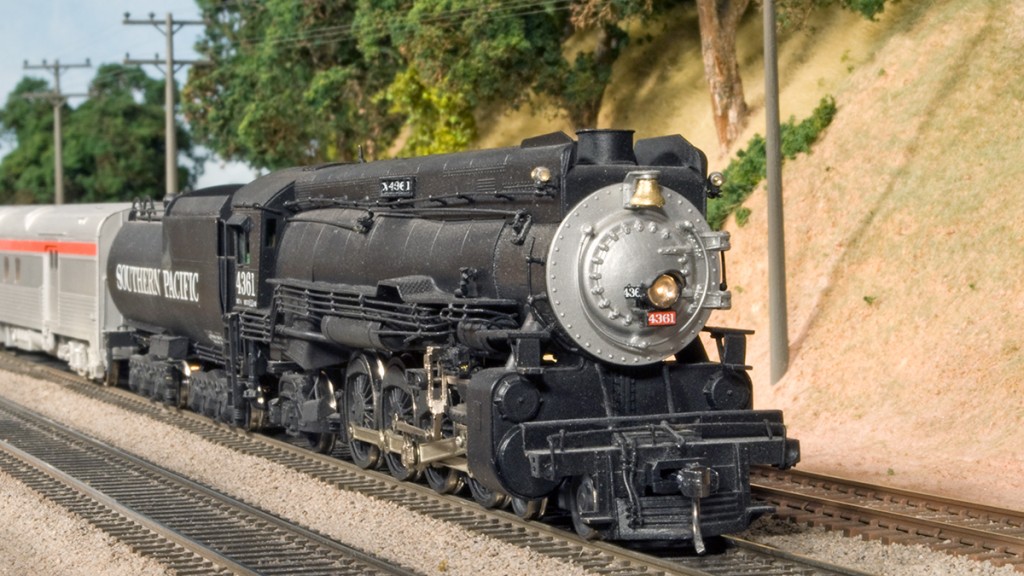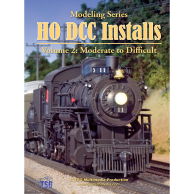
Sunset Brass SP Mt-4 4-8-2
Sunset Mt-4 4-8-2, Southern Pacific 4361
Overview
CV Programming – Soundtraxx Heavy Steam Tsunami
Review
This is a brass steam locomotive that I’ve had since the early 1990s. Being that old it was not DCC ready. This model does not fit my early 1990s era at all, but I’ve always admired these sleek SP Mountains. Sometimes a model comes along and you just have to have one.
This installation of the Tsunami was very similar to the installation in the Bachmann Spectrum 2-8-0 also on the DVD, so for this locomotive we focused on the installation of a Soundtraxx sound cam. Using a cam produces much more satisfactory synchronization of exhaust chuffs to driver rotation than can be achieved by trying to use CVs to synchronize a Tsunami.
CV Programming – Soundtraxx Heavy Steam Tsunami
Only common CVs or those that were changed from their default values are listed. Some settings reflect my personal preferences for speed matching and performance.
| CV | Value (decimal) | Notes |
| 2 (start speed) | 10 | This controls the minimum voltage applied to the motor at speed step 1. |
| 3 (acceleration) | 32 | This controls how quickly the locomotive changes speed when accelerating. |
| 4 (deceleration) | 22 | This controls how quickly the locomotive changes speed when decelerating. |
| 17 (extended address) | 209 | For locomotives with a 4-digit address, CV 17 and 18 together determine the address. To be honest I never try to set these manually. My Digitrax system does all this automatically for me when I program a 4-digit address. |
| 18 (extended address) | 9 | see CV17 |
| 25 (speed curve) | 2 | This value produces a nice, predictable, linear speed curve. The speed curve controls how the throttle setting corresponds to locomotive speed. I find non-linear curves annoying, as it is hard to judge how much the train speed is going to change when I turn the throttle knob. |
| 29 (configuration) | 50 | The setting of CV29 is complex. See your decoder instructions. Your DCC system may set CV29 for you when programming your locomotive’s address. If you need to modify CV29, it’s best to do it after setting the address. |
| 49 (headlight configuration) | 15 | 15 is the “Dyno-Light” option, which makes the light gradually brighten in sync with the dynamo sound. |
| 50 (backup light configuration) | 15 | 15 is the “Dyno-Light” option, which makes the light gradually brighten in sync with the dynamo sound. |
| 66 (forward trim) | 110 | Since Soundtraxx does not support CV5, using the forward and reverse trims is an alternate way to speed-match a Tsunami-equipped locomotive to the rest of your fleet. CV29 has to be set to enable speed tables, and a speed table type has to be selected with CV25 for this to work (but you don’t need to use a 28-step speed table. I used a simple linear table). |
| 95 (reverse trim) | 110 | see CV66 |
| 112 (sound configuration) | 128 | 128 enables the sound cam to mechanically synchronize exhaust chuffs to driver rotation. |
| 113 (quiet mode) | 0 | Setting this to 0 makes the locomotive sounds come on when the layout is powered up, even if the locomotive is not selected on a controller. |
| 115 (whistle select) | 3 | The steam Tsunamis offer a variety of whistle choices. I picked the one I liked best for this locomotive. |
| 129 (whistle volume) | 255 | This is the whistle sound volume. |
| 130 (bell volume) | 64 | This is the bell sound volume. |
| 131 (exhaust volume) | 64 | This is the exhaust chuff sound volume. |
| 133 (dynamo volume) | 26 | This is the dynamo sound volume. I turned this down quite a bit because I find the noise irritating after a while. |
| 153 (equalizer control) | 2 | This is the sound equalizer control. I used one of the presets that sounded good to my ear. |
| 201 (event probability – coal) | 0 | I set this to 0 to keep Fireman Fred from shoveling coal (one of the Tsunami’s random noises). This is an oil burner! |
| 209 (BEMF – Kp) | 32 | This is the BEMF Kp coefficient. I arrived at these values after many hours of experimentation, but like all my Tsunami’s, the performance is still a little rough, especially at low speeds. |
| 210 (BEMF – Ki) | 4 | This is the BEMF Ki coefficient. This one can make the locomotive run really badly if it’s set too high. |
| 212 (BEMF – intensity) | 200 | Turning this one down a little from the maximum of 255 helped to smooth the performance a little. Setting this CV to 0 will disable BEMF. |
| 213 (BEMF – sample period) | 8 | The purpose of CV213 and CV214 are not really explained that well in the documentation, but I found that turning them down from the default of 15 improved the smoothness of the locomotive somewhat. I also found that it works better to keep the values of CV213 and CV214 relatively close to one another. |
| 214 (BEMF – aperture time) | 5 | see CV213 |
Locomotive
Sharp-eyed SP steam fans may note that this model is not quite correct for SP 4361, mostly with regard to the valve gear. Unfortunately I painted and numbered it years ago before I had the reference material I do now. The paint is getting a little shopworn anyway, so when I get around to repainting it I may choose a new number for an SP Mt-4 that more closely matches the model.
This model came equipped with a Mashima can motor with low current draw, which was a plus. Also, this thing has one of the silkiest mechanisms I’ve ever encountered in a steamer. I think I got lucky. With the motor worm disconnected, the frame will glide down the track when pushed with no binding whatsoever.
The only modification I made to this locomotive mechanically was to swap the original rubber tube coupling between the motor and gearbox with an NWSL universal. Doing so also required the installation of a torque rod, which is just a piece of metal anchored to the gearbox to keep it from spinning on the axle. Without that the parts of the NWSL universal would not stay coupled together.
Decoder
The Soundtraxx Tsunami delivers outstanding sound quality and great lighting effects. There are myriad options to tweak the sounds. The Tsunami has more sound-related CVs than any other sound decoder I’ve encountered.
Unlike some other sound decoders, the Tsunami is not reprogrammable. It does come with several alternate whistles that can be changed by setting a CV. I do like the fact that Soundtraxx made all of the features of the Tsunami configurable through CV programming, so you don’t need a computer and proprietary hardware to get the most out of the decoder.
Unfortunately the motor control doesn’t measure up to the high standard set by the audio. Despite many hours of tweaking and trying all kinds of different combinations of values for the motor control CVs, I was not able to get this locomotive to run as smoothly as its excellent mechanism is capable of, and the starting speed was a little high. The values I eventually settled on seemed to produce the best performance.
The Soundtraxx sound cam works fairly well, though it does skip a chuff or produce a double chuff on occasion. Keeping the pickup wiper adjusted for proper tension against the back of the cam helps. The cam is a huge improvement over trying to keep the chuffs synchronized using CVs. With that method, the Tsunami will stay in sync at one speed, but go badly out of sync as the speed increases or decreases.


Comments are closed.